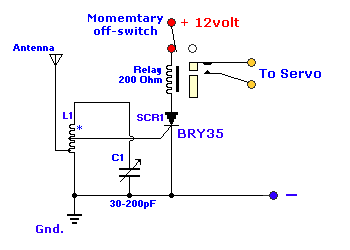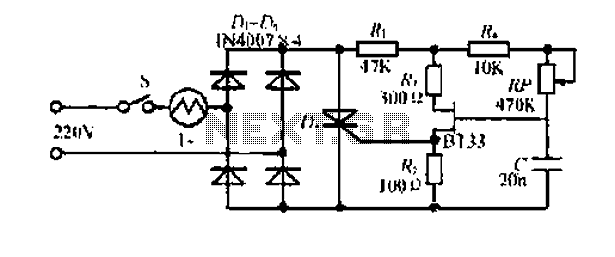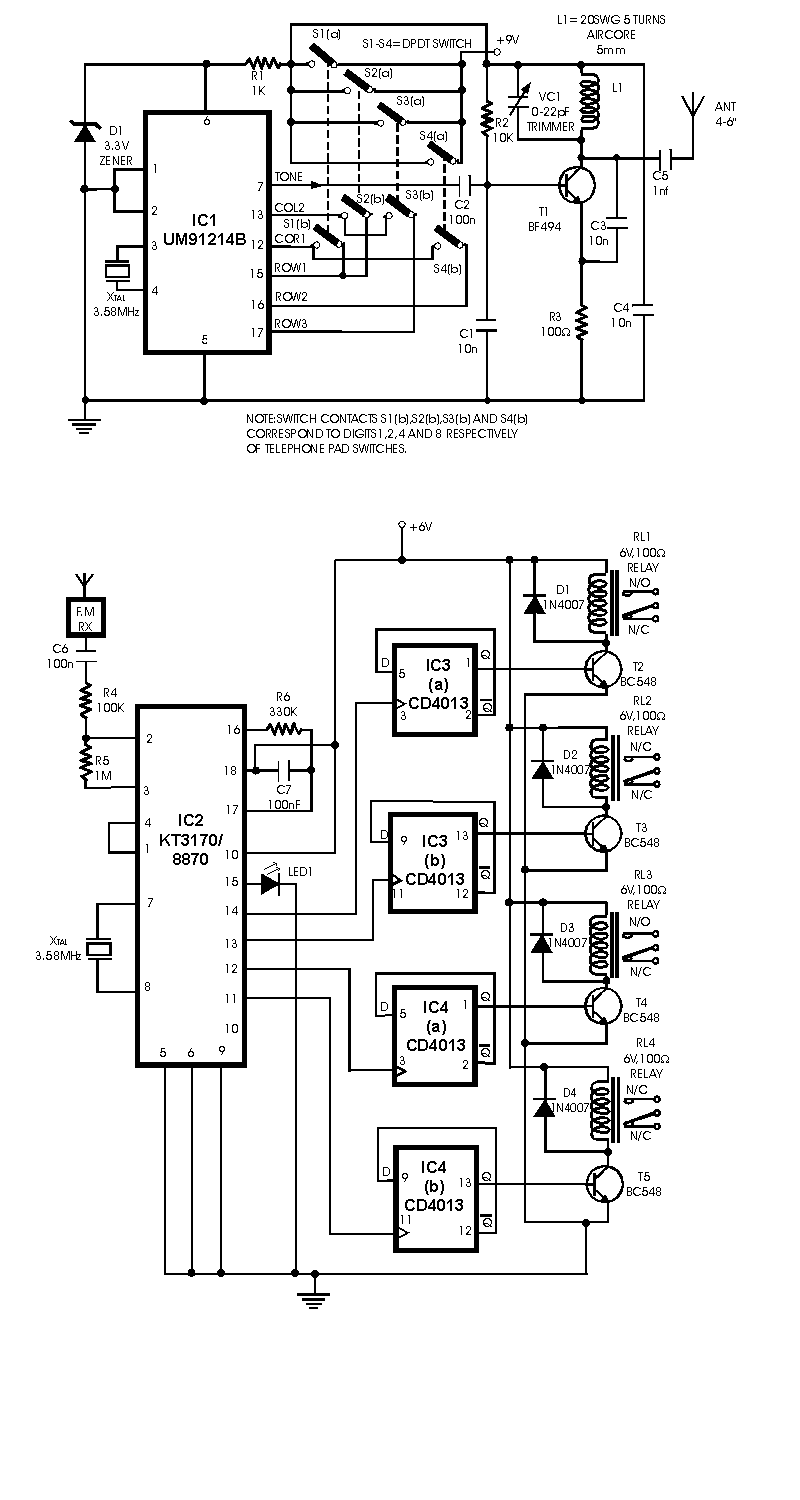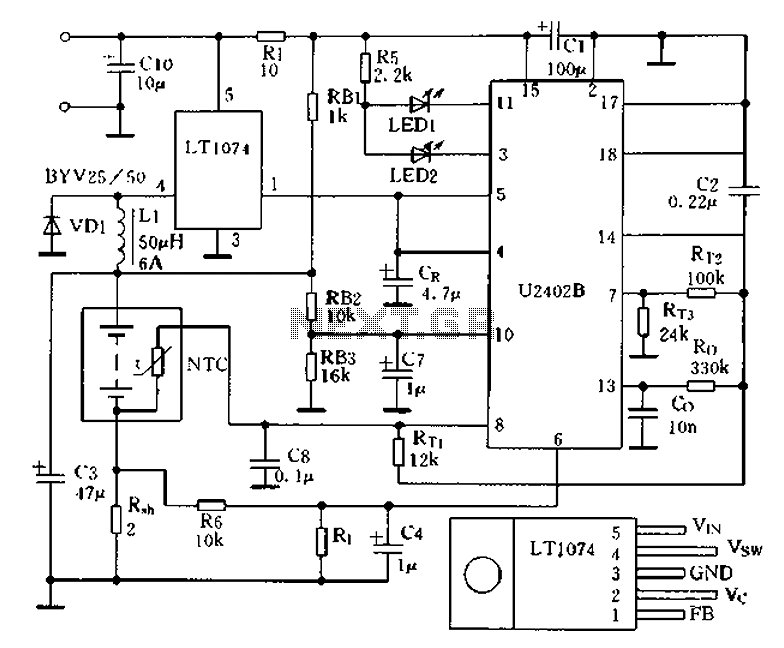
X’Mas LED Decoration circuit

This simple circuit can create an 18 LED flasher to decorate a Christmas tree. The white, blue, and red LEDs flash at different rates to provide a colorful display. It is a light-sensitive circuit, automatically activating in the evening and remaining on until morning. The circuit utilizes the popular binary counter IC CD4060 to flash the LEDs at various rates. Components C1, VR2, and R1 form the oscillator, with output pins 7, 5, and 4 toggling between high and low states sequentially. When one output becomes high, a set of three LEDs illuminates, and when the output goes low, another set turns on. This sequence is replicated in the other two sets of LEDs, albeit with different timings. The flashing speed can be adjusted using VR2. An LDR is connected with VR1 to activate the IC during the evening. In daylight, the LDR conducts and keeps reset pin 12 of IC1 high, preventing operation. When daylight fades, pin 12 goes low, allowing the flasher to function. VR1 adjusts the sensitivity of the LDR to the desired light level. To accommodate more LEDs, the supply voltage can be increased to 18 volts DC. The circuit can be powered using a standard 12-18 volt 500 mA adapter. High-bright transparent LEDs are recommended for an attractive display.
The circuit design employs a CD4060 binary counter IC, which is integral to generating the timing signals required for the LED flashing sequence. This IC features an internal oscillator that can be configured using external components such as resistors and capacitors. In this schematic, capacitor C1 and variable resistor VR2 are pivotal in setting the oscillator frequency, which directly influences the flashing rate of the LEDs. The variable resistor allows for fine-tuning of the flashing speed, providing flexibility depending on the user's preference.
The output pins of the CD4060 are utilized to drive the LEDs. Each output pin corresponds to a specific set of three LEDs, which are activated in a staggered manner to create a dynamic visual effect. The different timing intervals between the outputs are achieved through the inherent delay characteristics of the CD4060, resulting in a captivating display as the colors alternate.
The light-sensitive feature of the circuit is facilitated by the Light Dependent Resistor (LDR), which plays a crucial role in determining the operational state of the circuit based on ambient light levels. When light levels are sufficient, the LDR maintains a high state on reset pin 12, effectively disabling the circuit. As ambient light diminishes, the resistance of the LDR increases, causing pin 12 to go low and enabling the circuit to initiate its flashing sequence.
For enhanced performance, particularly in terms of visibility, the use of high-bright transparent LEDs is advised. These LEDs not only improve the aesthetic appeal of the display but also ensure that the light output is sufficient to attract attention, especially in low-light conditions. The circuit's power requirements can be met using a standard 12-18 volt DC adapter rated at 500 mA, ensuring reliable operation while accommodating a range of LED configurations.Using this simple circuit, you can make an 18 LED flasher to decorate the X`Mas Tree. The White, Blue and Red LEDs flash at different rates to give a colorful display. It is a light sensitive circuit so that it will turn on in the evening Using this simple circuit, you can make an 18 LED flasher to decorate the X`Mas Tree. The White, Blue and Red LEDs flash at different rates to give a colorful display. It is a light sensitive circuit so that it will turn on in the evening automatically and stays on till morning. The circuit uses the popular Binary counter IC CD 4060 to flash the LEDs at different rates. Components C1, VR2 and R1 form the oscillator and the output pins 7, 5 and 4 become high / low sequentially.
When one output turns high, a set of 3 LEDs turn on and when the same output turns off, the second set turns on. This sequence is similar in the other two sets of LEDs also but with different timings. The speed of the Flashing can be controlled through VR2. LDR is provided with VR1 to activate the IC in the evening. In day light, LDR conducts and keep the reset pin 12 of IC1 high to inhibit it from working. When the day light ceases, pin12 becomes low and the flasher starts working. VR1 adjusts the sensitivity of LDR at the required light level. If more LEDs are required, increase the supply voltage to 18 volt DC. The circuit can be powered using a standard 12-18 volt 500 mA adapter. Use High bright transparent LEDs for attractive display. 🔗 External reference
The circuit design employs a CD4060 binary counter IC, which is integral to generating the timing signals required for the LED flashing sequence. This IC features an internal oscillator that can be configured using external components such as resistors and capacitors. In this schematic, capacitor C1 and variable resistor VR2 are pivotal in setting the oscillator frequency, which directly influences the flashing rate of the LEDs. The variable resistor allows for fine-tuning of the flashing speed, providing flexibility depending on the user's preference.
The output pins of the CD4060 are utilized to drive the LEDs. Each output pin corresponds to a specific set of three LEDs, which are activated in a staggered manner to create a dynamic visual effect. The different timing intervals between the outputs are achieved through the inherent delay characteristics of the CD4060, resulting in a captivating display as the colors alternate.
The light-sensitive feature of the circuit is facilitated by the Light Dependent Resistor (LDR), which plays a crucial role in determining the operational state of the circuit based on ambient light levels. When light levels are sufficient, the LDR maintains a high state on reset pin 12, effectively disabling the circuit. As ambient light diminishes, the resistance of the LDR increases, causing pin 12 to go low and enabling the circuit to initiate its flashing sequence.
For enhanced performance, particularly in terms of visibility, the use of high-bright transparent LEDs is advised. These LEDs not only improve the aesthetic appeal of the display but also ensure that the light output is sufficient to attract attention, especially in low-light conditions. The circuit's power requirements can be met using a standard 12-18 volt DC adapter rated at 500 mA, ensuring reliable operation while accommodating a range of LED configurations.Using this simple circuit, you can make an 18 LED flasher to decorate the X`Mas Tree. The White, Blue and Red LEDs flash at different rates to give a colorful display. It is a light sensitive circuit so that it will turn on in the evening Using this simple circuit, you can make an 18 LED flasher to decorate the X`Mas Tree. The White, Blue and Red LEDs flash at different rates to give a colorful display. It is a light sensitive circuit so that it will turn on in the evening automatically and stays on till morning. The circuit uses the popular Binary counter IC CD 4060 to flash the LEDs at different rates. Components C1, VR2 and R1 form the oscillator and the output pins 7, 5 and 4 become high / low sequentially.
When one output turns high, a set of 3 LEDs turn on and when the same output turns off, the second set turns on. This sequence is similar in the other two sets of LEDs also but with different timings. The speed of the Flashing can be controlled through VR2. LDR is provided with VR1 to activate the IC in the evening. In day light, LDR conducts and keep the reset pin 12 of IC1 high to inhibit it from working. When the day light ceases, pin12 becomes low and the flasher starts working. VR1 adjusts the sensitivity of LDR at the required light level. If more LEDs are required, increase the supply voltage to 18 volt DC. The circuit can be powered using a standard 12-18 volt 500 mA adapter. Use High bright transparent LEDs for attractive display. 🔗 External reference





